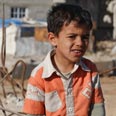
Gazans earn living by sifting sand in defunct settlements
Ruins in coastal enclave have become source of income for hundreds of men, women, and children around fighting areas from Cast Lead and area of destroyed settlements. To make money, they sift sand in order to make gravel and small pebbles needed for building
The continued blockade on the Gaza Strip has created a new social class in the coastal enclave, known as "the sifters." To earn a living, hundreds of men, women, and children, considered the poorest in the Strip, sift through sand in order to make gravel and other small pebbles necessary for building and paving roads.
The sifters are located throughout Gaza, but are concentrated mainly in areas in the northern Strip where there was heavy fighting during Operation Cast Lead and in the territory of settlements that were destroyed. They make their living off of piles of debris by doing back-breaking work that brings in meager income.
The al-Arabiya network did a news item on the sifters during which some of them were interviewed. Hamed Saad told the television station that he joined the sifters because he had a hard time finding any other source of income. He said that a day of sifting earns him NIS 30 (about $8) a day. "I try to earn even this little amount in order to feed by children instead of being out of work," he said.
A 14-year-old boy said that his father sent him to work because the aid the family receives does not cover their basic needs. "We need to work at this job. We want to live. No one asks about us, and we don't have any income that will let us live with dignity," said the boy.
'UNRWA helpless in face of poverty'
Adnan Abu Hasna, spokesman for the United Nations Relief and Works Agency (UNWRA) said in the item that the sifter phenomenon strengthened mainly after Operation Cast Lead due to the great damage to buildings and infrastructure it left behind. According to him, the blockade and unemployment have forced many Gazans to seek out new sources of income, including sifting.
Abu Hasna said that UNRWA is left helpless in the face of poverty in the Gaza Strip. The organization currently helps 8,000 refugees out of about one million living in the Strip. "The dramatic deterioration in people's lives in the Gaza Strip and the collapse of most of the production sector are beyond the powers of UNRWA or any other authority because of the growing human tragedy," he added.
In the meantime, the Hamas government is turning a blind eye to the phenomenon of poor people in general, and of the sifters in particular.
Khalil Abu Shamala, director of Al-Dameer Organization for Human Rights, criticized Hamas for neglect.
According him, when he saw women, children, and elderly sifting in order to sell gravel, he official contacted a number of ministers in the Hamas government. "I became pale, unfortunately, because they are doing nothing for these people," he said.
Abu Shamala does not agree with opinions being voiced in the Strip that sifting work is part of the response to the blockade. "This is unskilled labor born out of necessity and poverty. It will lead to serious effects on these workers, especially the children among them," he emphasized.
According to reports in the Gaza Strip, five sifters were wounded by IDF fire near Beit Lahiya on Monday.
Doron Peskin is head of research at Info-Prod Research (Middle East) Ltd.










